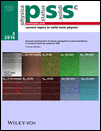Characterization of TiO2 antireflection coatings elaborated by APCVD for monocrystalline silicon solar cells
Abstract
In this work, high quality titanium dioxide thin films were grown by an efficient, less expensive and rapid method of Atmospheric Pressure Chemical Vapor Deposition (APCVD) from TiCl4 precursor for application as antireflection coatings on monocrystalline silicon solar cells with the aim to reduce the front surface reflection losses. The microstructural, electrical and optical properties of the produced coatings were successfully characterized by Atomic Force Microscopy (AFM), Four Point Probe (FPP) and Spectroscopic Ellipsometry (SE). The produced coatings were uniform, homogenous and relatively smooth. The density of the deposited TiO2 films is found to be ρ ′ = 3.11 g/cm3. The porosity of these films is estimated to ϕ = 24%. A perfect agreement between the AFM results and the ellipsometric results was confirmed. The refractive index of our TiO2 thin films was found to be n = 2.25 at the wavelength λ = 550 nm, with a thickness of 56.2 nm. Our results show the possibility to fabricate TiO2 layers with the optimal optical qualities required for antireflection coating, using the APCVD technique. An excellent agreement is reached between our experimental results and calculated results for TiO2 single-layer antireflection coating on monocrystalline silicon solar cells. The electrical resistivity of the deposited TiO2 films at 450°C annealed at 450°C for 1 hr, was found to be ρ = 1.7 × 10-3 Ω.cm. The sheet resistance of our TiO2 films was equal to R□ = 303 Ω/□. The obtained results demonstrate the real opportunity of the APCVD technique to prepare high quality antireflection coatings for high efficiency silicon solar cells. (© 2015 WILEY-VCH Verlag GmbH & Co. KGaA, Weinheim)




